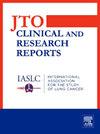Impact of the COVID-19 Pandemic on Diagnosis and Multidisciplinary Treatment of NSCLC in Ontario, Canada
IF 3.5
Q2 ONCOLOGY
引用次数: 0
Abstract
Introduction
The coronavirus disease 2019 pandemic disrupted cancer care delivery globally, with many jurisdictions reporting reductions in lung cancer diagnoses and delays in treatment. In Ontario, Canada, both institutional and provincial data have reported mixed trends in NSCLC presentation and care. This study aimed to assess the short-term impact of the coronavirus disease 2019 pandemic on NSCLC diagnoses and treatment pathways across Ontario using population-level data from Cancer Care Ontario administrative health databases.
Methods
We conducted a retrospective cohort study of patients diagnosed with NSCLC in Ontario between January 1, 2019 and December 31, 2020. The cohort was created using relevant diagnostic codes and linked provincial databases to evaluate diagnostic trends and access to surgical, medical, and radiation oncology services. Statistical analyses included Poisson regression to assess changes in diagnosis rates and multivariable linear regressions to evaluate wait times, adjusting for age, sex, income quintile, and geographic region.
Results
A total of 13,407 NSCLC cases were identified. There was a 6% overall decline in diagnoses in 2020, with a 31% drop during quarter 2 (April–June 2020). The mean wait times for surgical consultation and treatment and also medical and radiation oncology consults improved or remained stable. No delays were found in systemic therapy initiation. Multivariable analyses confirmed these findings.
Conclusions
NSCLC care delivery in Ontario remained stable during the early pandemic period. Declines in diagnosis warrant further investigation using longer-term data. Real-time data systems are essential for future pandemic preparedness and response.
COVID-19大流行对加拿大安大略省非小细胞肺癌诊断和多学科治疗的影响
2019年冠状病毒病大流行扰乱了全球癌症护理服务,许多司法管辖区报告肺癌诊断减少和治疗延误。在加拿大安大略省,机构和省级数据都报告了非小细胞肺癌的表现和治疗的混合趋势。本研究旨在利用安大略省癌症护理行政卫生数据库的人口水平数据,评估2019年冠状病毒病大流行对安大略省非小细胞肺癌诊断和治疗途径的短期影响。方法:我们对2019年1月1日至2020年12月31日在安大略省诊断为NSCLC的患者进行了回顾性队列研究。该队列是使用相关诊断代码和关联的省级数据库创建的,以评估诊断趋势和获得外科、医疗和放射肿瘤学服务的机会。统计分析包括泊松回归来评估诊断率的变化,多变量线性回归来评估等待时间,调整年龄、性别、收入五分位数和地理区域。结果共检出NSCLC病例13407例。2020年的诊断总体下降了6%,第二季度(2020年4月至6月)下降了31%。外科会诊和治疗以及内科和放射肿瘤学会诊的平均等待时间有所改善或保持稳定。未发现全身治疗开始延迟。多变量分析证实了这些发现。结论安大略省snsclc的护理在大流行早期保持稳定。诊断率的下降需要使用长期数据进行进一步调查。实时数据系统对于未来的大流行防范和应对至关重要。
本文章由计算机程序翻译,如有差异,请以英文原文为准。
求助全文
约1分钟内获得全文
求助全文
来源期刊

JTO Clinical and Research Reports
Medicine-Oncology
CiteScore
4.20
自引率
0.00%
发文量
145
审稿时长
19 weeks
 求助内容:
求助内容: 应助结果提醒方式:
应助结果提醒方式:


